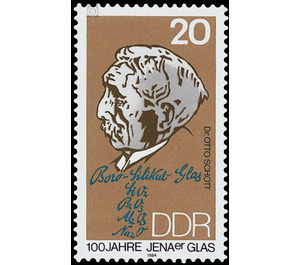100 years Jenaer Glas - Germany / German Democratic Republic 1984 - 20 Pfennig
Theme: Calender
| Country | Germany / German Democratic Republic |
| Issue Date | 1984 |
| Face Value | 20.00 |
| Color | brown |
| Perforation | K 12 1/2: 13 |
| Printing Type | offset |
| Stamp Type | Postage stamp |
| Item Type | Stamp |
| Chronological Issue Number | 2590 |
| Chronological Chapter | GER-DDR |
| SID | 290242 |
| In 17 Wishlists | |
100 years JENAer GLAS On the occasion of the jubilee "100 Years JENAer GLAS" the Ministry of Posts and Telecommunications of the German Democratic Republic issues a multicolored postage stamp. Special cancellation from January 10 to March 9, 1984 100 years JENAer GLAS The special postage stamp for the 100th anniversary of the founding of the JENAer GLASWERK reminds of an event that is inseparable from the outstanding academic personality Dr. JENAer GLASWERK. Otto Schott (17 December 1851 to 27 August 1935) is connected. The chemist, originally from Witten, Westphalia, who had been involved in the manufacture of glass since his childhood, had early convinced himself that a further development of glass production was only possible on a scientific basis. This basic idea found its reflection in the submitted at the University of Jena dissertation on the topic: "Contributions to the theory and practice of glass fabrication" (February 6, 1875). Regardless of this, the physicist Prof. dr. Ernst Abbe (1840-1905) as the founder of modern optics with regard to the optical glass at the same conclusion, because in his opinion any further progress in the optical device construction depended on glasses that did not exist at that time. As co-owner of the later world-famous company Carl Zeiss, he also had the opportunity to work in creative collaboration with Dr. Ing. Otto Schott newly developed glasses to test their usability. From this happy combination of the physics professor dr. Ernst Abbe with the glass chemist Otto Schott and the mechanic Carl Zeiss (1816-1888) came to the founding of the JENAer GLASWERK in 1884, which made it possible to achieve great scientific and technical achievements in the Zeisswerk but also in the field of technical glass and the term JENAer GLAS in all its range made known. To the great merits Otto Schotts can be counted on the implementation of the laboratory production of new glasses on a large scale and the associated introduction of modern technologies. As the most important invention Dr. Otto Schotts is not without reason the development of "Boro-silicate glasses" called. Their presentation and adaptation to the various purposes of the technology decisively shaped the name JENAer GLAS. For the progress of the optical development these glasses had a fundamental meaning. Prof. Dr. Ernst Abbe developed the first apochromatic microscope lenses in the world at the Zeiss factory in Jena with these glasses. They were also the prerequisite for the invention of the anastigmatic camera lenses by Paul Rudolph in the Zeiss factory in 1889. The "Boro-silicate glasses" were also used in technical glass for lamp cylinders, ampoules, thermometers, laboratory equipment, technical equipment, glass tubes and fireproof household glass. Of particular importance was the borosilicate glass known under the name "RASOTHERM". Even today, VEB JENAer GLASWERK, a company in the VEB Carl Zeiss Jena combine, develops and produces optical glass, household glass, technical glass and technical equipment as well as tube glass. Exemplary here is the constant development of new optical glasses, in order to meet the requirements for the wide-ranging perspective requirements of optical precision equipment construction or the development of technical equipment made of RASOTHERM glass according to the requirements of the chemical industry. The historically grown connection between science and production on this basis achieves its highest effectiveness.


